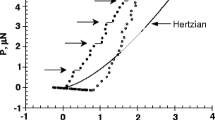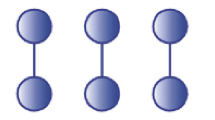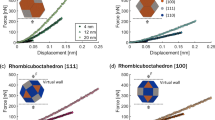Abstract
Nanoparticles (NPs) are widely used in many practical applications. However, their deformation behaviors and the subsequent effects on their mechanical properties in pure nanoparticle-modulated systems still remain unclear. These research challenges were systematically investigated using coarse-grained molecular dynamics simulations. Firstly, it was observed that both the stiffness and tensile strength of the NPs system were greatly influenced by the cohesion energy of the NPs under uniaxial tensile/compressive loads. It was also revealed that the larger the cohesion energy between neighboring particles, the stronger the stiffness and strength. Secondly, the distribution and evolution of the local virial stress component, σxx of the NPs system with varying εp of the NPs under tension and compression were also explored. Finally, the effect of particle size on the mechanical properties and deformation mode of the NPs system were discussed. These results have certain reference value for the optimal design of pure nanoparticle-modulated system materials.





Similar content being viewed by others
References
A.C. Balazs, T. Emrick, and T.P. Russell, Nanoparticle Polymer Composites: Where Two Small Worlds Meet, Science, 2006, 314, p 1107–1110.
A. Bansal, H. Yang, C. Li, K. Cho, B.C. Benicewicz, S.K. Kumar, and L.S. Schadler, Quantitative Equivalence Between Polymer Nanocomposites and Thin Polymer Films, Nat. Mater., 2005, 4, p 693–698.
Y.R. Huang, Y. Jiang, J.L. Hor, R. Gupta, L. Zhang, K.J. Stebe, G. Feng, K.T. Turner, and D. Lee, Polymer Nanocomposite Films with Extremely High Nanoparticle Loadings via Capillary Rise Infiltration (CaRI), Nanoscale, 2015, 7, p 798–805.
M.T. Byrne, J.E. McCarthy, M. Bent, R. Blake, Y.K. Gun’ko, E. Horvath, Z. Konya, A. Kukovecz, I. Kiricsi, and J.N. Coleman, Chemical Functionalisation of Titania Nanotubes and Their Utilisation for the fabrication of Reinforced Polystyrene Composites, J. Mater. Chem., 2007, 17, p 2351–2358.
G.M. Odegard, T.C. Clancy, and T.S. Gates, Modeling of the Mechanical Properties of Nanoparticle/Polymer Composites, Polymer (Guildf)., 2005, 46, p 553–562.
L.H. Li, J.C. Deng, H.R. Deng, Z.L. Liu, and L. **n, Synthesis and Characterization of Chitosan/ZnO Nanoparticle Composite Membranes, Carbohydr. Res., 2010, 345, p 994–998.
J. Jeon, V. Panchagnula, J. Pan, and A.V. Dobrynin, Molecular Dynamics Simulations of Mutilayer Films of Polyelectrolytes and Nanoparticles, Langmuir, 2006, 22, p 4629–4637.
J.M.Y. Carrillo and A.V. Dobrynin, Layer-by-layer Assembly of Polyelectrolyte Chains and Nanoparticles on Nanoporous Substrates: Molecular Dynamics Simulations, Langmuir, 2012, 28, p 1531–1538.
M.K. Hossain, Nanoassembly of Gold Nanoparticles: An Active Substrate for Size-Dependent Surface-Enhanced Raman Scattering Spectrochim, Acta-Part A Mol. Biomol. Spectrosc, 2020, 242, p 118759.
T. Kondo, S. Aoshima, K. Hirata, K. Honda, Y. Einaga, A. Fujishima, and T. Kawai, Crystal-Face-Selective Adsorption of Au Nanoparticles Onto Polycrystalline Diamond Surfaces, Langmuir, 2008, 24, p 7545–7548.
K. An and G.A. Somorjai, Size and Shape Control of Metal Nanoparticles for Reaction Selectivity in Catalysis, ChemCatChem, 2012, 4, p 1512–1524.
V. Amendola, R. Pilot, M. Frasconi, O.M. Maragò, and M.A. Iatì, Surface Plasmon Resonance in Gold Nanoparticles: A Review, J. Phys. Condens. Matter., 2017, 29, p 154.
C. Wang and S. Chen, Viscoelastic Properties of Randomly Entangled Carbon Nanotube Networks Under Cyclic Tension Loading, Comput. Mater. Sci., 2016, 119, p 46–51.
C. Wang, L. Wang, and Z. Xu, Enhanced Mechanical Properties of Carbon Nanotube Networks by Mobile and Discrete Binders, Carbon N. Y., 2013, 64, p 237–244.
C. Wang, B. **e, Y. Liu, and Z. Xu, Mechanotunable Microstructures of Carbon Nanotube Networks, ACS Macro Lett., 2012, 1, p 1176–1179. https://doi.org/10.1021/mz300422f
C. Wang, C. Zhang, and S. Chen, Micro-Mechanism and Influencing Factors of Graphene Foam Elasticity, Carbon N. Y., 2019, 148, p 267–276.
S.W. Cranford and M.J. Buehler, In Silico Assembly and Nanomechanical Characterization of Carbon Nanotube Buckypaper, Nanotechnology, 2010, 21, p 645.
E.P. Chan, W.D. Mulhearn, Y.R. Huang, J.H. Lee, D. Lee, and C.M. Stafford, Tailoring the Permselectivity of Water Desalination Membranes via Nanoparticle Assembly, Langmuir, 2014, 30, p 611–616.
R.J. Hardy, Formulas for Determining Local Properties in Molecular-Dynamics Simulations: Shock Waves, J. Chem. Phys., 1982, 76, p 622–628.
Y. Wu, C. Wang, and T. Yang, Aggregation of Nanoparticles and Their Effect on Mechanical Properties of Carbon Nanotube Networks, Comput. Mater. Sci., 2022, 202, p 110970.
G. Chen, Z. Ding, T. Huang, L. Yu, V. Ramakrishna, and J. Ward, Application of the Virial Theorem for Improving Eigenvalue Calculations of Multiparticle Systems, J. Comput. Appl. Math., 2017, 313, p 469–485.
Acknowledgments
This work is supported by Inner Mongolia Natural Science Foundation Project (Grants No. 2019MS01018); Basic research funds for universities directly under Autonomous region (Grants No. JY20220261); Inner Mongolia Natural Science Foundation (Grant No. 2019MS05064); Inner Mongolia University of Technology Foundation (Grant No.2020015).
Author information
Authors and Affiliations
Contributions
YW formulated the numerical model, conducted all simulations and drafted the paper. KL improved the language issues. All authors reviewed the manuscript.
Corresponding author
Ethics declarations
Competing interest
The authors declare no competing interest.
Additional information
Publisher's Note
Springer Nature remains neutral with regard to jurisdictional claims in published maps and institutional affiliations.
Appendices
Appendix: Simulation Codes
Relax.iN.

Tension.in.

Attachment
According to the generalization of the virial theorem, the average virial stress at a volume, Ωi, around particle, I, at position, ri, can be expressed as follows (Ref 21).
where m is the mass of a particle in the numerical sample, and ui is the relative displacement of i for the reference position. Hence, the material time derivative of ui is the thermal excitation velocity of the particle. The interparticle force, fij, applied on particle i by particle j is:
where Φij is the total energy of the coarse-grain ensemble, including the bead-spring and rotational-spring and pairwise interatomic potentials, as previously described.
Rights and permissions
Springer Nature or its licensor (e.g. a society or other partner) holds exclusive rights to this article under a publishing agreement with the author(s) or other rightsholder(s); author self-archiving of the accepted manuscript version of this article is solely governed by the terms of such publishing agreement and applicable law.
About this article
Cite this article
Wu, Y., Li, K. Deformation Behavior and Its Effect on the Mechanical Properties of Nanoparticles in Pure Nanoparticle-Modulated System. J. of Materi Eng and Perform 32, 8054–8062 (2023). https://doi.org/10.1007/s11665-022-07736-x
Received:
Revised:
Accepted:
Published:
Issue Date:
DOI: https://doi.org/10.1007/s11665-022-07736-x




